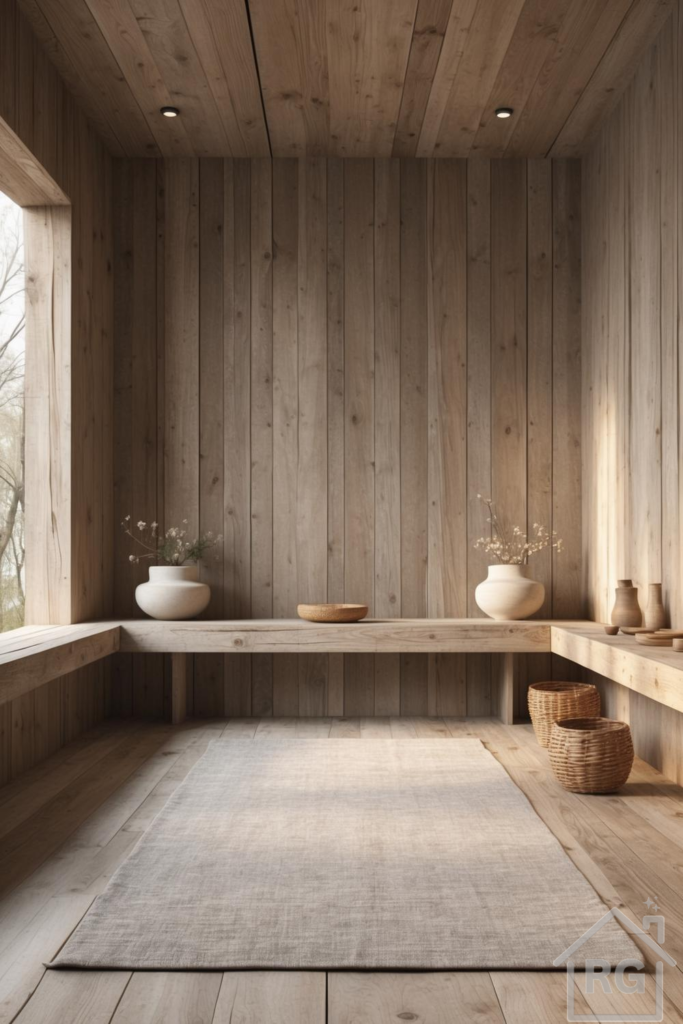
In our increasingly busy world, carving out a space dedicated solely to peace, reflection, and mindfulness is becoming less of a luxury and more of a necessity. A dedicated meditation or prayer room offers a sanctuary from the external chaos, allowing for deeper connection and inner calm. The Japandi design style, a harmonious blend of Japanese minimalism and Scandinavian functionality, provides the perfect aesthetic framework for creating such a space – emphasizing natural materials, simplicity, and tranquility. This guide explores how to design a serene Japandi meditation room, inspired by the principles of minimalism and natural beauty.
Embracing Japandi: The Foundation of Serenity
Japandi design thrives on the concept of ‘less is more’. It combines the rustic minimalism of Japanese aesthetics (‘wabi-sabi’, finding beauty in imperfection) with the warmth and comfort of Scandinavian design (‘hygge’). Key elements include:
- Natural Materials: Wood, bamboo, rattan, linen, cotton, ceramic, and stone are central.
- Neutral Palette: Earthy tones, muted colors, creams, soft greys, and the natural hues of wood dominate.
- Clean Lines & Simplicity: Uncluttered spaces, functional furniture, and minimal ornamentation.
- Emphasis on Craftsmanship: Appreciation for well-made, durable items.
- Connection to Nature: Incorporating natural light and organic elements.
Creating Your Japandi Meditation Room: Step-by-Step
1. The Canvas: Walls, Floor, and Ceiling
The room’s shell sets the tone. For an authentic Japandi feel, consider cladding walls and even the ceiling in light-toned wood panels, like pine, oak, or maple with a natural, matte finish. This creates an immersive, cocoon-like atmosphere. If full wood cladding isn’t feasible, opt for:
- Neutral Paint: Soft beige, warm grey, or off-white paint provides a clean, calm backdrop.
- Textured Plaster: Limewash or tadelakt can add subtle depth and natural texture.
- Flooring: Light wood flooring is ideal. Alternatively, a simple, low-pile area rug in a neutral color (like beige, grey, or cream) made from natural fibers like wool, jute, or cotton can define the meditation space and add softness underfoot. Ensure the rug is large enough to anchor the space but leaves some wood floor exposed.
2. Furnishing with Intention
Minimalism is key. Avoid cluttering the space. Focus on essential, functional pieces:
- Seating: A simple floor cushion (zafu), a low wooden bench, or even just the rug itself can serve as the primary seating. Built-in benches, as seen in the example image, offer seamless integration and maintain clean lines.
- Surfaces: If needed, include a very small, low table or shelf for essential items like a candle, incense, or a religious text. Keep surfaces largely clear.
- Storage (Optional): If storage is necessary, opt for concealed solutions like built-in cabinets or simple woven baskets to keep items out of sight and maintain tranquility.
3. The Power of Natural Light and Soft Illumination
Maximize natural light. Keep window treatments minimal – sheer linen curtains or simple wooden blinds allow light to filter through gently. For artificial lighting, choose warm, soft options:
- Recessed Lighting: Discreet ceiling spotlights provide ambient light without visual clutter. Install dimmers to control the mood.
- Floor/Table Lamps: Choose lamps with simple designs and natural materials (wood base, paper shade) for task or accent lighting, if needed.
- Candlelight: Introduce the soft flicker of candles (safely) for a calming ambiance during meditation or prayer.
4. Curating Minimalist Decor
Decor should be intentional and contribute to the room’s serene purpose. Focus on natural textures and simple forms:
- Ceramics: Simple, handcrafted vases or bowls in matte finishes (cream, beige, terracotta) add an earthy touch.
- Natural Elements: Display a few dried botanicals, branches, or smooth stones. Avoid overly complex floral arrangements.
- Woven Textures: Wicker or rattan baskets add warmth and texture, useful for discreet storage or simply as decorative elements.
- Artwork: If desired, choose one or two pieces of abstract art or nature-inspired prints with a muted palette and simple composition. Often, the texture of the wood itself is decoration enough.
5. Engaging the Senses (Subtly)
A meditation space engages more than just sight. Consider:
- Scent: Use subtle, natural scents like sandalwood incense, palo santo, or a high-quality essential oil diffuser (lavender, frankincense). Avoid overpowering fragrances.
- Sound: The goal is often quietude, but soft, calming music or nature sounds can aid meditation for some. Ensure the space is as soundproofed as possible from household noise.
- Touch: The textures of the wood, the rug, cushions, and ceramics contribute to the sensory experience. Choose materials that feel good to the touch.
Maintaining Your Sanctuary
A key principle of Japandi and minimalism is maintaining an uncluttered environment. Regularly tidy the space, ensuring only essential or meaningful items remain. Treat it as a sacred space, distinct from the rest of your home. Dust surfaces, care for any natural elements, and allow the room to breathe. The act of maintaining the space can itself become a mindful practice.
By thoughtfully combining the core tenets of Japanese minimalism and Scandinavian warmth, you can create a beautiful and deeply calming Japandi meditation room – a personal sanctuary designed for peace, reflection, and rejuvenation.
